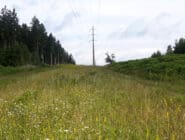
According to the National Interagency Fire Center, 68,988 wildfires burned more than 7.5 million acres of US land in 2022. Both statistics exceed their previous 10-year average, leading many people to wonder not only what issues have contributed to this increase but also what can be done to enhance wildfire mitigation efforts moving forward.
By John Kalthoff, Corteva Agriscience
Part of the issue at hand is driven by ecological and environmental factors. While earlier snowmelt and delayed rainfall have led to extended drought in recent years, tree mortality and the spread of invasive plants have provided more fuel sources for wildfires.
But what’s igniting wildfires in the first place? Although unattended campfires, acts of arson, and lightning are common culprits, a recent five-year study conducted by the California Department of Forestry and Fire Prevention found that electrical power causes nearly 10% of wildfires annually.
In addition to posing a threat to electrical transmission reliability, fallen trees can impact energized conductors and lead to downed powerlines, both of which can ignite wildfires. To make matters worse, woody plants and other brush species can be ladder fuels, which carry low-burning wildfires to taller vegetation. These issues alone give utility vegetation managers reason to prioritise brush control as part of their annual right-of-way (ROW) management programmes. However, industry research has shown that not all brush control strategies deliver the same results.
Considerations for Brush Control
The best way for electric utilities to reduce wildfire risks is to selectively control incompatible trees and brush species throughout their right-of-way corridors. This selectivity is crucial, as it allows vegetation managers to eliminate threats to utility infrastructure without causing harm to desirable plant species that strengthen wildfire mitigation programmes.
Despite the benefits selective control strategies can provide, some electric utilities still use mechanical mowing practices to manage incompatible plant species. As a nonselective approach to vegetation control, exclusive mowing practices decimate all plant species, stimulating costly regrowth and spreading incompatible seeds along the way.
Fortunately, utility vegetation managers can use Integrated Vegetation Management (IVM) strategies to avoid these detrimental issues. That’s because IVM programmes, using industry best management practices, complement mechanical and biological control methods with targeted applications of selective herbicides, which strengthen woody plant management and minimize off-target control issues. As a result, industry practitioners can successfully yield landscapes that are compatible with not only utility infrastructure but also wildfire mitigation programmes.
Supported by Environmental ROW Research
Findings generated by the State Game Lands 33 (SGL 33) research project in central Pennsylvania, which has analysed the ecological impact of different vegetation control methods since the early 1950s, have indicated the benefits of using IVM strategies to manage incompatible plant species throughout utility rights-of-way. For example, when SGL 33 researchers with Pennsylvania State University recently tested five common control methods on 2.5 to 3-acre plots to determine which strategies best support the establishment of tree-resistant cover types throughout utility rights-of-way, selective applications of nonselective herbicide chemistries yielded the most promising results.
Each plot included a 95-foot wire zone and 30-foot border zone on each side of the transmission line corridor. In addition to hand-cutting and mechanical mowing practices, three herbicide-based control methods were tested:
- High-volume foliar
- Low-volume foliar
- Low-volume basal
Three years after treatment, SGL 33 data showed that low-volume and high-volume foliar herbicide applications predominately yielded lower incompatible stem densities in the wire zone and border zone than their mechanical counterparts. (See Graph 1)

Lower stem counts were observed on plots treated with low-volume basal applications. It’s worth noting that no incompatible trees were recorded in the wire zone of one of the plots treated with a low-volume basal application, and a second low-volume basal plot yielded stem counts lower than mechanically treated sites.
“Reducing incompatible stem counts throughout utility rights-of-way provides multiple benefits to electric utilities and their vegetation management partners,” said Jerome Otto, market development specialist, Corteva Agriscience. “You’re not only enhancing electrical service reliability by protecting utility infrastructure; you’re also achieving results that can help safeguard adjacent communities from the devastating effects of wildfires.”
As a longtime funding partner of SGL 33, Corteva Agriscience shares findings from the long-standing environmental research study to help industry partners understand how different vegetation control strategies can help them improve cost-efficiency, enhance environmental sustainability and reduce the risk of wildfire. As far as the brand’s industry experts are concerned, electric utilities and their vegetation management partners have a significant opportunity to achieve these benefits through IVM, especially if they prioritise selectivity.
“SGL 33 research has indicated the benefits of integrating various herbicide applications as part of an IVM-based approach,” said Darrell Russell, market development specialist, Corteva Agriscience. “Industry practitioners can further enhance these positive results and reduce incompatible stem counts by selectively treating targeted vegetation with selective herbicide chemistries. By only controlling plant species that represent the greatest threats, vegetation managers can help beneficial plant communities thrive, which positively impacts right-of-way management programmes, the environment, and surrounding communities.”
In addition to reducing incompatible stem densities — which eliminates flammable trees and creates ample spacing between less flammable plant species — targeted applications of selective chemistries can complement IVM-based programmes by supporting the development of beneficial grasses and forbs. In turn, these low-growing plant communities yield multiple benefits for ROW management and wildfire mitigation programmes, including:
Fewer ladder fuels
High-risk fire areas are often riddled with numerous ladder fuels, such as low-lying trees and brush species. By supplementing mechanical and biological control methods with selective applications of selective herbicide chemistries, IVM programmes can prevent the establishment and growth of ladder fuels, which reduces the risk of flames reaching canopy heights.

Fuel break establishment
Selective herbicide treatments can help vegetation managers establish fuel breaks throughout utility rights-of-way, which can impede the spread of wildfire. Starting in the wire zone, vegetation managers can use herbicide treatments to control trees and other forms of tall-growing plant species to help establish fuel breaks composed of grasses, herbs and small shrubs. These low-growing plant communities reduce the risk of power line interference and inhibit flames from spreading, which allows firefighters to suppress the flames more safely and effectively.
Reduced maintenance input costs
Put simply, using IVM practices to reduce the amount of incompatible stems and ladder fuels throughout utility ROW can effectively lower maintenance costs over time. With less vegetation to maintain, industry practitioners can reallocate resources to at-risk sites or other programme needs.
Biodiverse habitat support
By supporting the development of beneficial grasses and forbs, IVM programmes also enhance habitat biodiversity for bees, butterflies and a variety of other native wildlife species. Intentionally managing both compatible and incompatible vegetation also can qualify IVM programmes for Environmental, Social and Governance (ESG) reporting when associated practices prove to yield no net loss or net positive impact on biodiversity.
Partnership Opportunities
Electric utilities aren’t the only entities that can positively impact wildfire mitigation efforts. While foresters and federal agencies can complete fuel-reduction projects to support timber harvest plans, city and state agencies can establish fuel breaks along roadsides to improve transportation routes during wildfires and related emergencies. State and national parks also can remove dead and hazardous trees to reduce the amount of flammable vegetation throughout at-risk areas.
“We’ve seen electric utilities assist private companies and federal agencies with logging activities near their right-of-way corridors,” Otto said. “This work includes the removal of controlled trees that otherwise interfere with line-clearance requirements. Instead of increasing fuel loads by leaving that brush on site, some entities use chippers to manually broadcast woody plants at lower levels throughout previously treated areas.”
Put simply, building relationships and effectively communicating with like-minded entities can help utility vegetation managers synchronize their treatment cycles, enhance fuel break establishment and mitigate wildfire risks throughout ROW corridors and adjacent land. While some landowners are skeptical of certain IVM practices, including herbicide applications, this cooperative support can improve public perception concerning best practices for wildfire mitigation efforts.
“We care for the land as much as the people who live on or adjacent to it,” Otto said. “The more vegetation managers and their industry partners can educate landowners on the benefits and objectives IVM-based strategies achieve, the more we’ll be able to drive communal understanding. What’s good for utility infrastructure also can be good for the land and surrounding communities. We’re working to spread that message far and wide.”
Originally published on Power Grid International.
About the Author

John Kalthoff is a portfolio marketing lead with Corteva Agriscience. In his role, he leverages more than 30 years of experience to provide product marketing leadership for the U.S. Land Management (non-crop vegetation management) business. He is based out of Indianapolis, IN.








